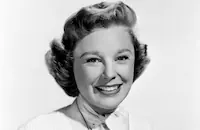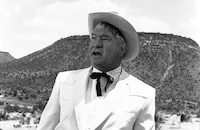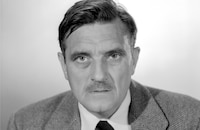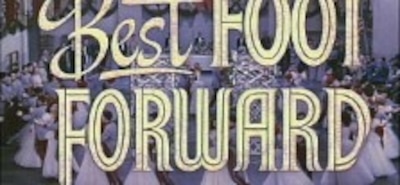Best Foot Forward

Brief Synopsis
Cast & Crew
Edward Buzzell
Lucille Ball
William Gaxton
Virginia Weidler
Tommy Dix
Nancy Walker
Film Details
Technical Specs

Synopsis
On the eve of Winsocki Military Institute's senior prom, graduating cadet Elwood C. "Bud" Hooper is in a conundrum because movie star Lucille Ball has unexpectedly accepted his prom invitation, but he has already submitted his girl friend Helen Schlessenger's name to the graduation review committee. Although Bud has told Helen that he is too sick to attend the prom, he is unsure what to do with Lucille, as it is too late to submit another name. Bud's cadet friends, Dutch Miller and Harvey "Hunk" Hoyt, convince Bud to take Lucille under Helen's name, unaware that Lucille's sole purpose in coming to Winsocki is to gain some much-needed publicity for her sagging career. Soon after Lucille and her agent, Jack O'Riley, check into their hotel, bumbling photographer Chester Short of the Philadelphia Bugle arrives, having been summoned by Jack. Jack's plan to get a photo of Lucille and Bud together backfires when Helen shows up, furious because she has heard that Bud is not sick, but is taking another woman to the prom. Seeing Bud's obvious distress and Helen's jealousy, Lucille asks Jack to call off the stunt, but Jack assures her that everything will work out. At the prom, as a depressed Helen mopes about the ladies' waiting room, Bud slips in, anxious to apologize. Helen gladly accepts the apology until Bud asks her to allow Lucille to go to the dance in her stead. Her jealousy reignited, Helen throws Bud out of the waiting room, after which Dutch and Hunk, whose own dates are unaware of their involvement with Lucille, escort the actress to the chaperoned dance. Much to Lucille's dismay, Dutch and Hunk, who are anxious to have her to themselves, insist on dancing with her in dark corners. Jack, meanwhile, is forced to sneak in to the prom disguised as a waiter, then is chased off by the ever-vigilant Captain Bradd. When homely blind date Nancy is accidentally given Lucille's fur stole by the hat check boy, the movie star's presence is suddenly made known. Just as a disgruntled Lucille is about to leave, Jack convinces Bud that Lucille is worried about him, and he agrees to ask her to dance the traditional "ring" waltz with him. Believing that she is doing him a favor, Lucille accepts his invitation and is publicly introduced as Helen during the formal dance. Upon hearing her name called, Helen storms into the dance hall and confronts Lucille, angrily ripping a flower from her gown. The starstruck cadets then descend on the actress and tear her clothes to shreds for souvenirs. Chester captures the riotous moment on film, and a half-dressed Lucille runs from the hall screaming. Bud hides Lucille in his dorm room closet, and she is soon joined by Jack, Chester, Helen and Nancy. When an angry Bradd comes looking for Lucille, Bud manages to allay his suspicious for a while, but Bradd eventually discovers the interlopers. The next day, Lucille is annoyed to see a titillating photo of her and the cadets in the Bugle and denounces Jack. Just then, Bud shows up at her hotel to say goodbye and lies that he has straightened everything out with Bradd and Helen. After Bud leaves, Helen arrives and tells Lucille that Bud will not be graduating that day. Feeling responsible for Bud's plight, Lucille decides to plead his case to Major Roger W. Reeber. Although sympathetic, Reeber reveals that Bud's military future is in the hands of the school's board of officers, which is headed by Colonel Harkrider. Lucille charms Reeber into bringing the matter up to the board and coaches him on how to make the dress incident sound like all-American fun. Lucille's ploy works, and while she watches the proceedings with a starstruck Colonel Harkrider, Bud graduates and is embraced by a forgiving Helen.

Director

Edward Buzzell
Cast

Lucille Ball
William Gaxton

Virginia Weidler
Tommy Dix

Nancy Walker

June Allyson

Kenny Bowers

Gloria Dehaven
Jack Jordan

Beverly Tyler

Chill Wills

Henry O'neill

Sara Haden

Donald Macbride
Bobby Stebbins
Darwood Kaye

Morris Ankrum

Nana Bryant
Harry James
Helen Forrest
Jack Wagner
Hugh Sheridan
Jack Mcgee
Billy Bletcher
Robert E. O'connor
Art Thompson
Lulu Mae Bohrman
Harry Hayden
Isabel Randolph

Bess Flowers

Stanley Donen
Crew
Leo Arnaud
Count Basie
George Bassman
Ralph Blane
Irving Brecher
Jack Dawn
Jack Donohue
Fred Finklehoffe
Arthur Freed
Cedric Gibbons
Mildred Griffiths
Lennie Hayton
Leroy Holmes
Irene
Henri Jaffa
Harry James
Natalie Kalmus
Dorothy Kingsley
Hugh Martin
Jack Matthias
Nikolay Rimsky-korsakov
Bill Ryan
Conrad Salinger
Blanche Sewell
Douglas Shearer
Julian Silberstein
Leonard Smith
Gile Steele
Charles Walters
Edwin B. Willis

Photo Collections
Film Details
Technical Specs

Articles
Best Foot Forward
MGM's leading musical producer, Arthur Freed, discovered Best Foot Forward during a visit to New York in 1941. Enchanted with the show's youthful exuberance and lilting score (including the hit "Buckle Down, Winsocki"), he asked studio head Louis B. Mayer to pick up the rights for him. Unfortunately, Columbia Pictures had beaten him to the punch, with their head, Harry Cohn, planning the film as a vehicle for Rita Hayworth. He had also signed Glenn Miller's orchestra as the prom band and Shirley Temple to co-star as the girl who almost loses her man to the visiting star. When Freed insisted that the film would do well for MGM, Mayer convinced Cohn to back off for $25,000 and the loan of Gene Kelly to co-star with Hayworth in another musical, Cover Girl (1944). Even that would prove a boon to MGM. Not only did the film help make Kelly a star, but it gave him the chance to work out the choreographic ideas that would make his later films among the best screen musicals ever.
Initially, Freed offered the role of the visiting star to Lana Turner, feeling it would provide her with a comic change of pace and a chance to showcase her beauty in Technicolor. When Turner became pregnant (with Cheryl Crane), she had to bow out of the production, which opened the door for Ball. In her first film at the studio, Dubarry Was a Lady (1943), hairdresser Sydney Guilaroff had given her the red hair that would become her trademark. She also was taking advantage of Buster Keaton's presence on the lot as a gag writer; with his help she would develop the comic expertise she would later bring to I Love Lucy. Best Foot Forward also brought her the chance to work with veteran Broadway musical star William Gaxton (a big hit on-stage as the U.S. President in George Gershwin's Of Thee I Sing) and a new friend in June Allyson.
With Nancy Walker, Tommy Dix, Jack Jordan, Kenny Bowers and Gil Stratton, Allyson had been brought from New York to re-create her role in Best Foot Forward. Of all of them, she was the one who would make the biggest splash in Hollywood (Walker would return to the stage, where she would reign as a star until moving into television in the '70s; Stratton wouldn't hit it big until he became a CBS sportscaster decades later). But Allyson wasn't happy there at first. She had arrived on the West Coast with $10 in her pocket only to learn that filming had been postponed six weeks. Fortunately, the studio gave her a small but splashy role in Girl Crazy (1943), which kept a roof over her head. But she missed her life in New York City and the boyfriend she had left behind. When she confided in Ball that she was planning to leave Hollywood as soon as possible, Ball shared her own heartaches over trying to gain a toehold in show business. Dazzled by Ball's stardom, her beauty and her happy life as Mrs. Desi Arnaz (little did she know the problems Lucy and Desi were already having), all Allyson could say in response was, "Yes, but you're tall." They would remain close throughout their careers. On their next film together, Meet the People (1944), Allyson would fall for leading man Dick Powell, despite the fact that he was still married to Joan Blondell. Ball would let them meet secretly at her ranch in order to avoid a public scandal.
In a rare move for Hollywood, Freed kept most of the original score in his film version of Best Foot Forward. All that were added were a few specialties for Harry James and his band, including James's signature number, "Flight of the Bumblebee." Chuck Walters, who would move to directing with Allyson as his star in Good News (1947), staged the musical numbers. The highlights include his inspired military drills for "Buckle Down, Winsocki" and a trio of dance styles for "The Three B's," in which Allyson, Walker, and Gloria DeHaven extolled the virtues of the barrel hop, the boogie-woogie, and the blues.
Although Best Foot Forward was hardly a trend-setter like such later Freed films as Meet Me in St. Louis (1944) or Singin' in the Rain (1952), it kept audiences happy for its 94-minute running time. It cost a mere $1.1 million to make and brought back $2.7 million in rentals, a decent profit for the time.
Producer: Arthur Freed
Director: Edward Buzzell
Screenplay: Irving Brecher, Fred F. Finklehoffe, based on the musical by Hugh Martin, Ralph Blane and John Cecil Holm
Cinematography: Leonard Smith
Art Direction: Cedric Gibbons, Edward Carfagno
Music: Lennie Hayton, Hugh Martin, Ralph Blane
Cast: Lucille Ball (Herself), William Gaxton (Jack O'Riley), Virginia Weidler (Helen Schlesinger), Tommy Dix (Elwood), Nancy Walker (Nancy), Gloria DeHaven (Minerva), Kenny Bowers (Dutch), June Allyson (Ethel), Jack Jordan (Hunk), Beverly Tyler (Miss Delaware Water Gap), Chill Wills (Chester Shoat), Henry O'Neill (Maj. Reeber), Sara Haden (Miss Talbert), Donald MacBride (Capt. Bradd), Harry James and His Music Makers, Helen Forrest (Herself), Mickey Rooney (Himself), Gil Stratton, Stanley Donen.
C-95m. Closed captioning.
by Frank Miller

Best Foot Forward
Best Foot Forward - Lucille Ball in BEST FOOT FORWARD - An Amazon Exclusive on DVD!
Adapted from a hit Broadway show, Best Foot Forward is basically a college musical with the college in this case played by the fictional Winsocki Military Institute. A young cadet has written a fan letter to Lucille Ball asking her to the prom, never expecting that she'll actually show up. But show up she does, along with her manager who sees this as a great way to drum up a little extra publicity. Unfortunately, the cadet's prom date isn't so high on the idea. Ball is delightful and sexy playing herself, and she shows off some very pleasing comic timing, though she is far from the only attraction. June Allyson, Gloria DeHaven and Nancy Walker shine as prom dates, and supplying fine Hugh Martin-Ralph Blane music throughout is Harry James and His Music Makers band.
It's especially nice to see June Allyson in her feature debut since the actress died only within the last year. She and Nancy Walker were both imported from the Broadway production of Best Foot Forward by producer Arthur Freed, who certainly knew talent when he saw it (or heard it). The Broadway show, in fact, was enough for MGM to sign Allyson to a studio contract; a year later, with the monster hit Two Girls and a Sailor (1944), she became a star.
Walker also makes her movie debut in Best Foot Forward, practically stealing the show with her sharp wisecracks - most of which are aimed squarely at her plain-Jane self. "For everyone else it's a dance. For me it's a concert," she quips. "I'd hang myself but I got a dentist appointment on Tuesday," she jokes. Walker later played "Rosie the waitress" in a series of Bounty paper towel commercials, in addition to a hit television career. Here, she and Allyson and DeHaven all get to show off their dancing skills in the film's best number, "The Three B's," in which they take turns making cases for three musical styles: the barrel house, the boogie-woogie and the blues. The energy of this song-and-dance number is infectious, and it's worth noting that it and all the other musical numbers were directed by Charles Walters, who would go on to direct the best college musical of the era, Good News (1947), which also starred Allyson. His work in Best Foot Forward reveals that he already knows how to use wide shots for maximum impact, something sorely lacking in modern movie musical numbers.
Other songs in this picture include "Buckle Down, Winsocki," the lovely ballad "You're Lucky" (with Ball's voice dubbed by Gloria Grafton), and the energetic "Alive and Kickin'," in which Walker sings on her own and dances to comic effect with Harry James. Indeed, James has quite a bit more to do in this movie than just lead his band, with some occasional dialogue and dancing and one funny moment where his entire band shouts "Lucille Ball!" as a throwaway joke. Mostly, though, the movie is a fun showcase for his band's musical talents.
Extras include the trailer, an excellent cartoon and a so-so short film. The cartoon, One Ham's Family, is a delightfully mean-spirited and clever Tex Avery concoction. The short, The Knight is Young (1938), is one of a series of musical subjects featuring Allyson before her feature career got going, and it's really of interest only for that reason.
There are far less pleasant ways to spend an hour and a half than by experiencing the bright color and lighthearted entertainment value of Best Foot Forward, and Warner's DVD looks superb, with nary a scratch.
For more information about Best Foot Forward, visit Warner Video. To purchase Best Foot Forward, visit Amazon and do a search by title.
by Jeremy Arnold
Best Foot Forward - Lucille Ball in BEST FOOT FORWARD - An Amazon Exclusive on DVD!
Quotes
Trivia
Notes
According to Hollywood Reporter news items, Columbia Pictures and producer Lester Cowan made the first bid for the screen rights to the hit Broadway production of Best Foot Forward, but called off its purchase deal in May 1942. M-G-M then acquired the rights for $150,000 and announced that director Vincente Minnelli and composer Roger Edens would be working on it. Lana Turner was to co-star with June Allyson and Nancy Walker, but was replaced by Lucille Ball after Turner revealed that she was pregnant. In July 1942, Mervyn LeRoy was announced as the film's director, and Mitzi Green tested for a role in the picture. Gene Kelly, who was the dance director of the Broadway production, and Ray MacDonald were announced as Turner's probable co-stars in July 1942. MacDonald was dropped from consideration after he joined the Medical Corps in August 1942. Robert Alton was hired as the film's choreographer in August 1942, but was eventually replaced by Charles Walters. In October 1942, Hollywood Reporter reported that Lee Bowman was being considered as Ball's co-star.
Allyson (1917-2006) and Walker (1922-1992), both of whom appeared in the Broadway show with Rosemary Lane, made their screen debuts in the film. Lane portrayed a movie star in the Broadway show, but, unlike the film version, did not appear as herself. Although Allyson shot her small role in Girl Crazy prior to Best Foot Forward, Best Foot Forward was released first. Reviewers commented favorably on both actresses' performances. The Variety review described Walker as a "comedienne of wide talents; stumbling, mugging, singing and dancing with veteran timing," and Allyson as a "looker and good vocalist." Tommy Dix, Kenny Bowers and Jack Jordan also made their screen debuts in the picture. All three had appeared in the Broadway production, but were not cast in same roles. Dix played "Greenie" in the stage version, Bowers played "Hunk" and Jordan played "Dutch." Gil Stratton, who played "Bud" in the Broadway show, was brought to Hollywood at the same time as his co-stars, but was cast in Girl Crazy. Although she earlier had appeared in the 1943 M-G-M production The Youngest Profession, Best Foot Forward was first film in which actress Beverly Tyler was billed under her stage name rather than her real name, Beverly Jean Saul.
Several songs from the Broadway show were dropped for the film, but were replaced by new songs by the show's composers, Hugh Martin and Ralph Blane. The music for "Buckle Down Winsocki" was used later in a popular public service song titled "Buckle Up for Safety." Gloria DeHaven made her singing debut in Best Foot Forward. Modern sources state that Stanley Donen, who was Gene Kelly's assistant on the Broadway show and later became a director, worked as an assistant to choreographer Jack Donohue, as well as appearing in the film's chorus. Best Foot Forward was his first picture.
Hollywood Reporter and M-G-M publicity news items list the following performers as cast members: George Rowland, Ellis Weiner, John Traul, Carl Russell, Sam Kamie, Mac Garn, Carl Rothenberg, Ken Wilson, Jack Coffey, James Pilcher, Bradley Hail, John Allbule, Norris Durham, Ralph Hoopes, Dale Lefler, George Lockett, Joseph "Corky" Geil, Richard Dick, Milton Chisholm, Herb Lurie, Fred Jenel, Riley Thompson and Don Gallaher. The appearance of these actors in the completed film has not been confirmed, however. On November 20, 1954, Marilyn Maxwell and Robert Cummings starred in an NBC television network broadcast of the musical, which was adapted by Neil Simon.















